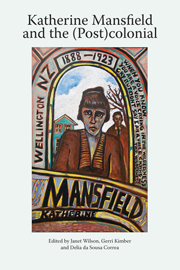Book contents
- Frontmatter
- Contents
- List of Illustrations
- Acknowledgements
- Colophon
- Introduction
- Criticism
- Katherine Mansfield: Cannibal
- Mansfield as (Post) colonial-Modernist: Rewriting the Contract with Death
- Colonialism and the Need for Impurity: Katherine Mansfield, ‘The Garden Party’ and Postcolonial Feeling
- ‘How Katherine Mansfield was Kidnapped’: A (Post) colonial Family Romance
- ‘Unmasking’ the First-Person Narrator of In a German Pension
- Workmanship and Wildness: Katherine Mansfield on Edith Wharton's The Age of Innocence
- Home and Abroad in the South Pacific: Spaces and Places in Robert Louis Stevenson and Katherine Mansfield's Short Fiction
- Literatures of Expatriation and the Colonial Mansfield
- Creative Writing
- Reports
- Reviews
- Notes on Contributors
- Katherine Mansfield Society
Home and Abroad in the South Pacific: Spaces and Places in Robert Louis Stevenson and Katherine Mansfield's Short Fiction
from Criticism
Published online by Cambridge University Press: 05 March 2014
- Frontmatter
- Contents
- List of Illustrations
- Acknowledgements
- Colophon
- Introduction
- Criticism
- Katherine Mansfield: Cannibal
- Mansfield as (Post) colonial-Modernist: Rewriting the Contract with Death
- Colonialism and the Need for Impurity: Katherine Mansfield, ‘The Garden Party’ and Postcolonial Feeling
- ‘How Katherine Mansfield was Kidnapped’: A (Post) colonial Family Romance
- ‘Unmasking’ the First-Person Narrator of In a German Pension
- Workmanship and Wildness: Katherine Mansfield on Edith Wharton's The Age of Innocence
- Home and Abroad in the South Pacific: Spaces and Places in Robert Louis Stevenson and Katherine Mansfield's Short Fiction
- Literatures of Expatriation and the Colonial Mansfield
- Creative Writing
- Reports
- Reviews
- Notes on Contributors
- Katherine Mansfield Society
Summary
Introduction
We children of the future, how could we be at home in this today? We feel disfavour for all ideals that might lead one to feel at home even in this fragile, broken time of transitions; as for ‘realities,’ we do not believe that they will last.
Friedrich NietzscheNietzsche's rendering of fin de siècleangst anticipated Heidegger's famous dictum that ‘Homelessness is coming to be the destiny of the world’, which aptly captures the modernist malaise – a malaise that characterises so much of Katherine Mansfield's writing. As a restless wanderer and permanently uprooted cosmopolitan she would most likely have agreed with Nietzsche on the instability of ‘realities’; yet she seemed to yearn for more durable ones. In her penultimate letter to her husband a few weeks before her death, she exclaimed, ‘[I]f I were allowed one single cry to God that cry would be I want to be REAL? Robert Louis Stevenson, a contemporary of Nietzsche, whose writing is now commonly classified as ‘proto-modernist’, was similarly aware of discontinuity and rupture. In his essay ‘The Day After Tomorrow’, Stevenson declares: ‘The obscurest epoch is today; and that for a thousand reasons of inchoate tendency, conflicting report, and sheer mass and multiplicity of experience; but chiefly, perhaps, by reason of an insidious shifting of landmarks.’ ‘Shifting landmarks’ is a catchword for both Stevenson and Mansfield's experiences. This essay does not propose a psycho-biographical reading of their work. Rather, it will examine related questions of home and belonging as well as of displacement and alienation, studying how characters in selected short stories position themselves in and against the physical and cultural geography of the South Pacific.
- Type
- Chapter
- Information
- Katherine Mansfield and the (Post)colonial , pp. 102 - 115Publisher: Edinburgh University PressPrint publication year: 2013



